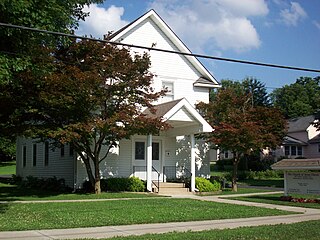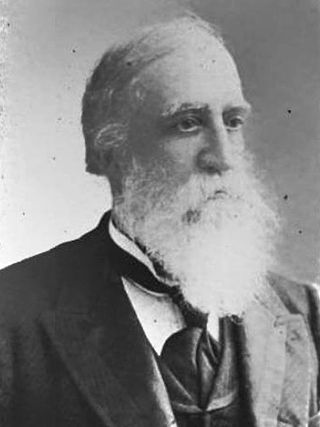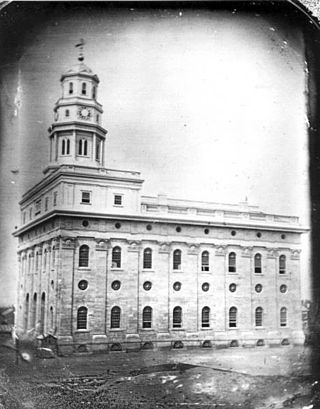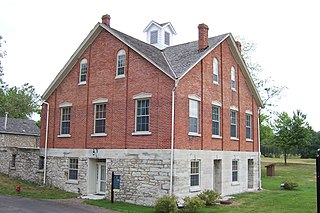
The Red Brick Store in Nauvoo, Illinois, was a building that was constructed and owned by Joseph Smith, the founder of the Latter Day Saint movement.

The Red Brick Store in Nauvoo, Illinois, was a building that was constructed and owned by Joseph Smith, the founder of the Latter Day Saint movement.

Smith constructed the Red Brick Store in 1841. The building became a center of economic, political, religious, and social activity among the Latter Day Saints. In addition to being a mercantile store, the second floor of the building also served as the headquarters of the Church of Jesus Christ of Latter Day Saints for a period of time. Members would visit the store to pay their tithing and other offerings to the church.
A number of important events in Latter Day Saint history occurred in the Red Brick Store, including:

After Joseph Smith was killed and the majority of Latter Day Saints left Nauvoo, the Red Brick Store fell into disrepair. Eventually, it was torn down and the bricks were used to construct new buildings in Nauvoo.
In 1980, the Reorganized Church of Jesus Christ of Latter Day Saints (now known as the Community of Christ) rebuilt the Red Brick Store on the original foundation as part of its 1980 sesquicentennial celebrations. The reconstructed Red Brick Store is now owned and operated by the Church of Jesus Christ of Latter-day Saints, which purchased the structure on March 5, 2024 as part of a larger sale of historically significant artifacts and properties by the Community of Christ. [1]
In Manti, Utah, the headquarters of the True and Living Church of Jesus Christ of Saints of the Last Days (TLC Church) is located in a building named the Red Brick Store in honor of Smith's original structure in Nauvoo.

Nauvoo is a small city in Hancock County, Illinois, United States, on the Mississippi River near Fort Madison, Iowa. The population of Nauvoo was 950 at the 2020 census. Nauvoo attracts visitors for its historic importance and its religious significance to members of several groups: The Church of Jesus Christ of Latter-day Saints; the Community of Christ, formerly the Reorganized Church of Jesus Christ of Latter Day Saints (RLDS); other groups stemming from the Latter Day Saint movement; and the Icarians. The city and its immediate surrounding area are listed on the National Register of Historic Places as the Nauvoo Historic District.

The Church of Jesus Christ (Cutlerite) is a denomination of the Latter Day Saint movement headquartered in Independence, Missouri, United States. The church derives its epithet from its founder, Alpheus Cutler, a member of the Nauvoo High Council and of Joseph Smith's Council of Fifty. Cutler justified his establishment of an independent church organization by asserting that God had "rejected" Smith's organization—but not his priesthood—following Smith's death, but that Smith had named Cutler to a singular "Quorum of Seven" in anticipation of this event, with a unique prerogative to reorganize the church that no one beyond this group possessed. Hence, Cutler's organization claims to be the only legitimate Latter Day Saint church in the world today. Currently, it has only one branch, located in Independence. The Cutlerite church retains an endowment ceremony believed to date to the Nauvoo period, practices the United Order of Enoch, and accepts baptism for the dead, but not eternal marriage or polygamy.

The Latter Day Saint movement is a religious movement within Christianity that arose during the Second Great Awakening in the early 19th century and that led to the set of doctrines, practices, and cultures called Mormonism, and to the existence of numerous Latter Day Saint churches. Its history is characterized by intense controversy and persecution in reaction to some of the movement's doctrines and practices and their relationship to mainstream Christianity. The purpose of this article is to give an overview of the different groups, beliefs, and denominations that began with the influence of Joseph Smith.

Washing and anointing is a ritual purification ordinance, similar to chrismation, that is part of the temple endowment ceremony practiced by the Church of Jesus Christ of Latter-day Saints and Mormon fundamentalists.

Joseph Smith III was the eldest surviving son of Joseph Smith and Emma Hale Smith. Joseph Smith III was the Prophet-President of what became the Reorganized Church of Jesus Christ of Latter Day Saints, renamed Community of Christ in 2001, which considers itself a continuation of the church established by Smith's father in 1830. For fifty-four years until his own death, Smith presided over the church. Smith's moderate ideas and nature set much of the tone for the church's development, earning him the sobriquet of "the pragmatic prophet".

The Nauvoo Illinois Temple is the 113th dedicated temple of the Church of Jesus Christ of Latter-day Saints. It is the third such temple that has been built in Illinois.

The Nauvoo Temple was the second temple constructed by the Church of Jesus Christ of Latter Day Saints. The church's first temple was completed in Kirtland, Ohio, United States, in 1836. When the main body of the church was forced out of Nauvoo, Illinois, in the winter of 1846, the church attempted to sell the building, finally succeeding in 1848. The building was damaged by fire and a tornado before being demolished.

John Alpheus Cutler was an early leader in the Latter Day Saint movement who founded the Church of Jesus Christ (Cutlerite) in 1853. He had previously served in several church positions under Joseph Smith, founder of the Latter Day Saint movement, as well as captain of Smith's personal bodyguard and "Master Builder and Workman on all God's Holy Houses." Following the death of Joseph Smith in June 1844, Cutler at first followed the Twelve Apostles under Brigham Young, but later left Young's church to reorganize the Church of Jesus Christ, with himself serving as its first president. Cutler claimed that this was the sole legitimate continuation of Smith's organization, and he served as its leader until his death.

In the Latter Day Saint movement, a temple is a building dedicated to being a house of God and is reserved for special forms of worship. A temple differs from a church meetinghouse, which is used for weekly worship services. Temples have been a significant part of the Latter Day Saint movement since early in its inception. Today, temples are operated by several Latter Day Saint denominations. The most prolific builder of temples of the Latter Day Saint movement is the Church of Jesus Christ of Latter-day Saints. The LDS Church has 335 temples in various phases, which includes 188 dedicated temples, 52 under construction, and 95 others announced. Several others within the movement have built or attempted to build temples. The Community of Christ operates two temples in the United States, which are open to the public and are used for worship services, performances, and religious education. Other denominations with temples are the Apostolic United Brethren, the Church of Christ, the Fundamentalist Church of Jesus Christ of Latter-Day Saints, and the Righteous Branch of the Church of Jesus Christ of Latter-day Saints.
George Miller was a prominent convert in the Latter Day Saint movement and was the third ordained bishop in the Latter Day Saint church.

The Plano Stone Church was constructed in 1868 to serve as the headquarters for the Reorganized Church of Jesus Christ of Latter Day Saints under the leadership of Joseph Smith III. Smith moved to Plano, Illinois, in 1866 and in 1867 was appointed head of the Stone Church's building committee. Smith and the committee selected the site, design and builder for the structure. The Plano Stone Church served as the headquarters of the RLDS from its completion in 1868 until Smith, his family, and the church moved to Lamoni, Iowa, in 1881.

Nauvoo Historic District is a National Historic Landmark District containing the city of Nauvoo, Illinois. The historic district is nearly coterminous with the City of Nauvoo as it was incorporated in 1840, but it also includes the Pioneer Saints Cemetery, the oldest Mormon cemetery in the area, which is outside the town boundary.
The history of Nauvoo, Illinois, starts with the Sauk and Meskwaki tribes who frequented the area, on a bend of the Mississippi River in Hancock County, some 53 miles (85 km) north of today's Quincy. They called the area "Quashquema", in honor of the Native American chief who headed a Sauk and Fox settlement numbering nearly 500 lodges. Permanent settlement by non-natives was reportedly begun in 1824 by Captain James White. By 1830, the community was called "Venus", and it was the site of the first post office in the county. In 1834 the name Venus was changed to "Commerce" in anticipation that the town would prosper under the United States' westward expansion.

In the Church of Jesus Christ of Latter-day Saints, a temple is a building dedicated to be a House of the Lord. Temples are considered by church members to be the most sacred structures on earth.

The Joseph Smith Mansion House in Nauvoo, Illinois is a building constructed by Joseph Smith, the founder of the Latter Day Saint movement. Smith used the house as a personal home, a public boarding house, a hotel, and as a site for the performance of temple ordinances.

The Nauvoo House in Nauvoo, Illinois, is a boarding house that Joseph Smith, the founder of the Latter Day Saint movement, began constructing in the 1840s. The boarding house was never completed, but the structure was later converted into a residential home and renamed the Riverside Mansion. The Nauvoo House, as it is referred to today, is part of the Nauvoo Historic District, a National Historic Landmark.
In the theology of the Latter Day Saint movement, an endowment refers to a gift of "power from on high", typically associated with the ordinances performed in Latter Day Saint temples. The purpose and meaning of the endowment varied during the life of movement founder Joseph Smith. The term has referred to many such gifts of heavenly power, including the confirmation ritual, the institution of the High Priesthood in 1831, events and rituals occurring in the Kirtland Temple in the mid-1830s, and an elaborate ritual performed in the Nauvoo Temple in the 1840s.

The following outline is provided as an overview of and topical guide to the life and influence of Joseph Smith:

Monument to Women Memorial Garden is a statuary monument in Nauvoo, Illinois, owned by the Church of Jesus Christ of Latter-day Saints. The monument is a two-acre garden with twelve statues depicting traditional women's roles. It was constructed in the 1970s to serve as a replacement for the Relief Society monument and designed to promote the woman's values which the LDS Church believed were threatened by the Equal Rights Amendment (ERA). Dennis Smith and Florence Hansen sculpted the bronze statues and church president Spencer W. Kimball dedicated the monument on June 30, 1978.